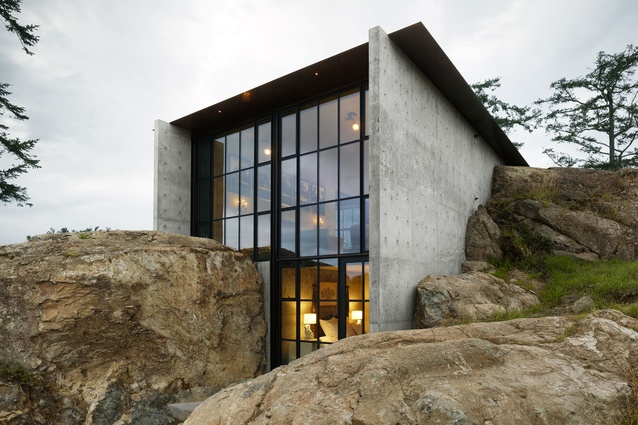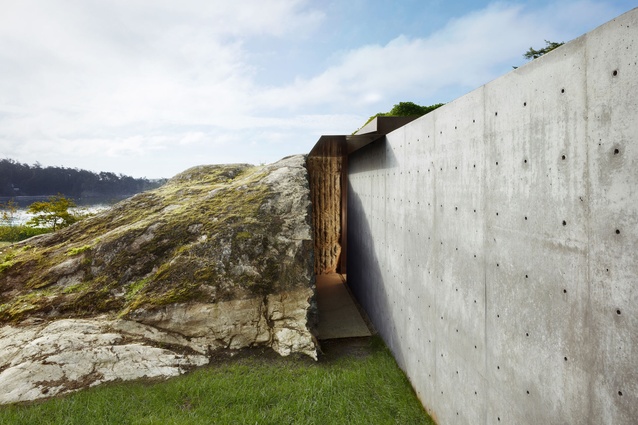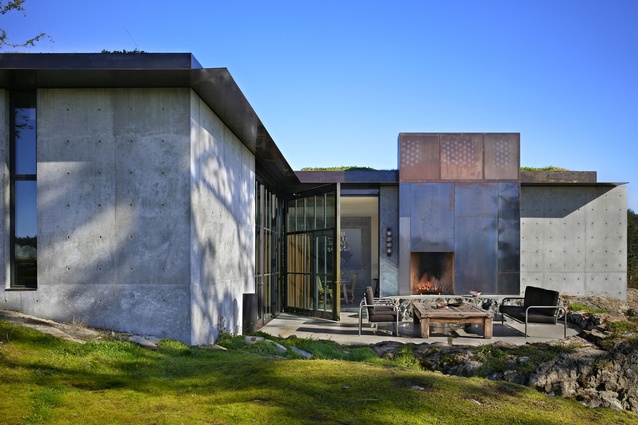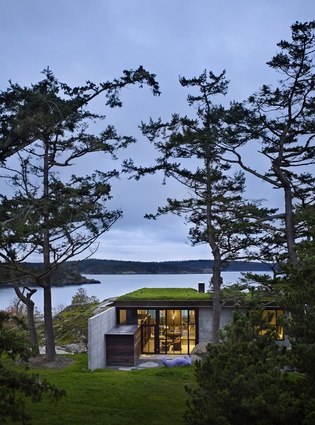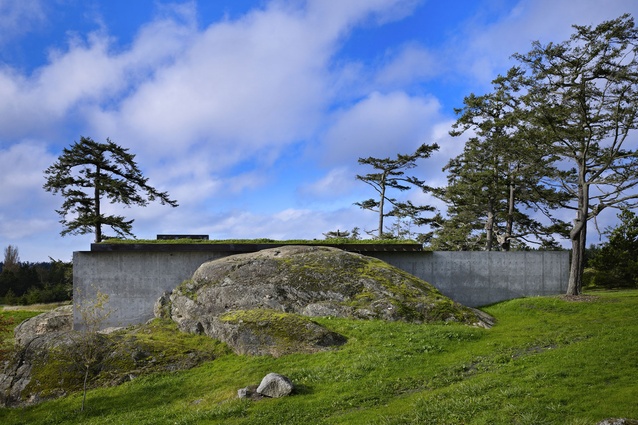Hot House: The Pierre
It took dynamite, hydraulic chippers, diamond-tipped drills, chisels and a measure of poetry to conjure up The Pierre from a mountain-top boulder.
As the story goes, the massive stone on Lopez Island (off the coast of Seattle, in the Salish Sea between the United States and Canada) was a favourite landmark for the landowner and she wanted to incorporate it somehow into the design of her holiday home.
Initially, the stone was reluctant to be cut up and broke in unpredictable ways. The floor plan is said to have crumbled and been re-sculpted accordingly with the remaining, unmovable stone serving as a material for aesthetic and functional details. The hearths for indoor and outdoor fireplaces were carved directly into the rock with concrete forming the remaining shapes. Flashes of the mineral rupture through walls and windows, connecting the indoor and outdoor areas. Ground-up stone was used as aggregate for the floor. The larger chunks – piled atop each other – became the walls for the garage.

Aside from the grand, theatrical gesture of putting a home within a rock, there are also delicate usages for the natural material. One of the most striking happens to be in the home’s handbasins. The master suite’s sink is made up of three small pools polished onto a portion of the boulder; water from the tap cascades from one to the next, echoing the way rainwater behaves on the rock just outside the window. The small, cave-like guest washroom by the home’s entrance is burrowed into the stone and accessorised with a forged copper basin and an elongated mirror that shoots up a light duct drilled through the boulder and into the room. The effect is almost medieval but it also hints at contemporary art’s current predilection for abstraction (think Korean/New Zealand artist Suji Park) and, weirdly, it also has a touch of the playfulness of Steampunk.
“Putting the house in the rock follows a tradition of building on the least productive part of a site, leaving the best parts free for cultivation,” said architect Tom Kundig of Olson Kundig Architects. The Pierre’s vocabulary is intrinsically tied to its 59-year-old maker and it is almost impossible to separate this pad, built in 2010, from the impressive, highly awarded pieces that make up the bulk of Kundig’s portfolio.
“Each project is connected to the next… they are all part of a continuum,” he says and it’s true. The 230m² home quotes Kundig’s The Brain – a stunning working studio for a film-maker in a bush-clad site in Seattle – in its indoor-outdoor flow and cube-like practicality. The use of concrete and stone, drilled light ducts and bunker aesthetics appear in his 2002 Mission Hill Winery. The respect and desire to bring nature into the home’s interior is present in many of his previous projects. At The Pierre, rainwater and the environment’s salinity are expected to rust the rolled-steel and perforated steel-plate cap on the outdoor fireplace and awnings; water will tint the material permanently and in entirely unexpected ways. The roof has been covered in grass to help it blend into its surroundings.
The Pierre (French for stone) was commissioned by an art collector, which was nothing new for Seattle-based Kundig (once described by a critic as “a poet and a butcher”); his most iconic residences (Princeton Architectural Press has devoted two major books to them) have been commissioned by clients in the creative sectors.
“A lot of my clients are risk-takers,” he says. “They understand and appreciate the risks involved with creating something – the cost, the time and the intimacy. Being respectful of that trust and risk is critical to success.”
What has emerged from these collaborations is a strong vocabulary that draws from Kundig’s personal past, an emphasis on craft and an ability to find unexpected solutions with flair.
Kundig’s work often draws from elements of his childhood in semi-rural, mining, lumbering and farming areas. He regularly incorporates “gizmos”, as he calls them, from America’s industrialist past: chunky railroad components, camshafts, forged steel, pivots, pulleys, chains, levers and even steam-powered mechanisms.
These kinetic, tactile mementoes tend to resolve functional puzzles. In The Pierre, this is noticeable in a library that opens up (into a utility room rather than a secret spy hovel), enormous glass panelling that swivels open and some of the fixtures (also designed by Kundig), such as light panels, which are reminiscent of old railroad switch lights.
The industrial streak throughout the home does not end there. The entrance is tunnel-like: a narrow and tall hallway sandwiched between the sliced-up boulder and a concrete wall (with exposed tie holes). The raw concrete and glass palette, mixed with steel and recycled timbers (on the bookshelves and throughout the home), hints at the process of construction and leaves the materials transparent and accessible. Although the architect says no special considerations had to be given to the owner’s art collection, the ceiling height provides ample space for exhibition and the bunker structure gives the impression that something valuable is being safeguarded there.
Olson Kundig Architects have accomplished a piece that is grand in its ideas and thorough in its attention to detail and delivery. It’s a house where theatricality and bold gestures, mechanics and industrial nous seem to mix seamlessly with art and a deep sensibility to the surrounding nature.

